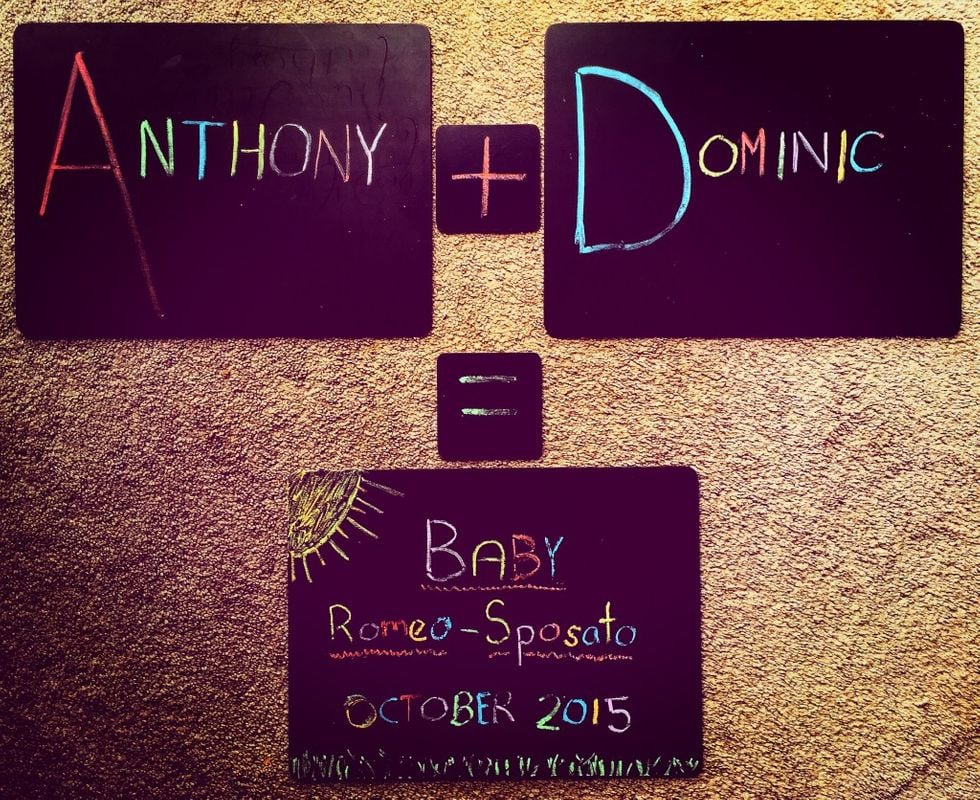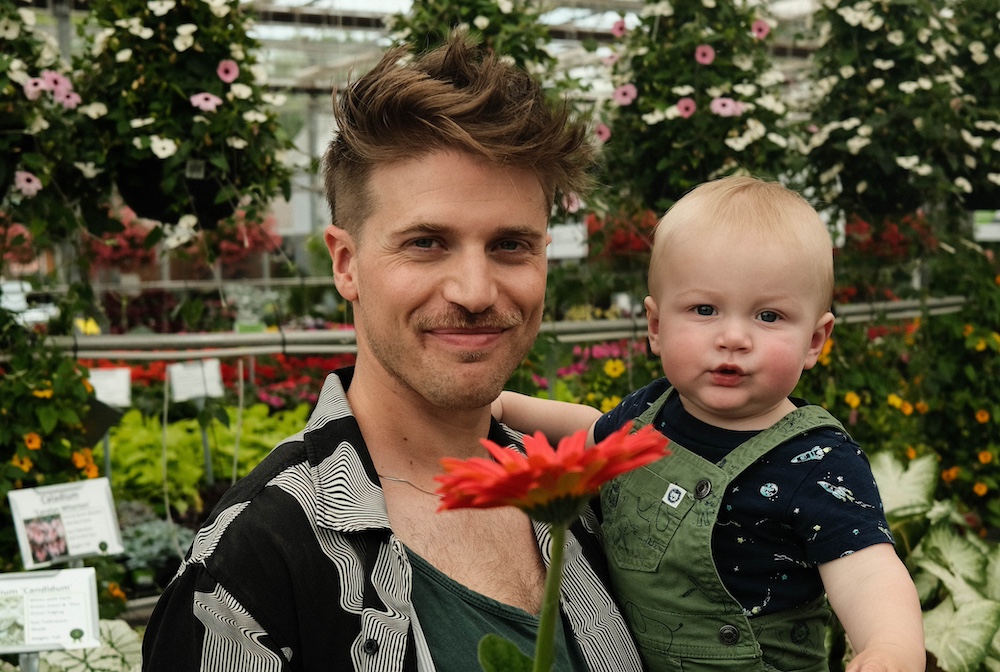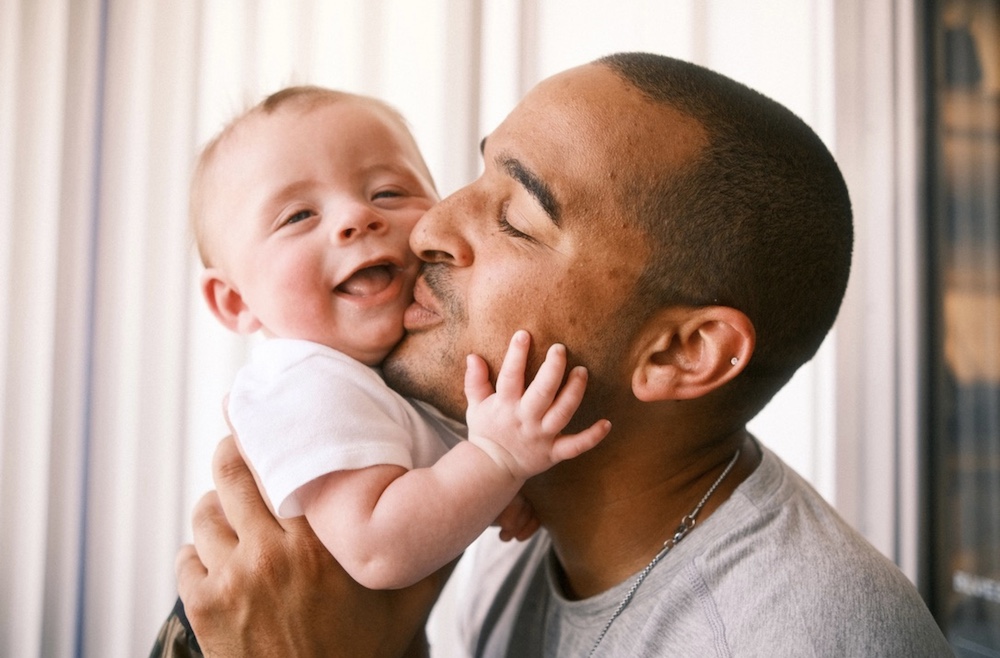It is Sunday, October 4. With the smell of pumpkin spice lattes and warm apple cider in the air, my husband Dom and I have found ourselves in a coffee shop, awaiting a couple of very important ladies. We are nervous, we are anxious, we are excited. And then, with a whisper of autumn wind at her back, in walks the birth mother of our daughter. And inside that swollen tummy of hers, the baby. We are, for the first time, in the same room as our daughter.
This meeting has happened at the request of the birth mother, who we will refer to moving forward as Bio Mom, because who doesn’t love a nickname? Bio Mom felt comfortable with us after weeks of texting and phone calls, to request a casual in-person meeting with us. The conversation is light, comfortable. We are feeling each other out, learning how we’ll speak to one another. I am too polite, laughing too hard, feeling too much, nodding my head with the furious shakings of a teenager at his first rave.
But it goes well. She is feeling good. There is heartburn, there is near-constant peeing, but the pregnancy is moving comfortably towards its conclusion in the coming weeks. We all have our eyes on a calendar in our heads, awaiting both the beginning and end of an incredible story. And so we discuss her hospital birth plan.
As I mentioned in a previous piece, when a woman is going to deliver a child, she fills out a hospital plan, making her wishes about the process very clear to the hospital. It’s an incredibly well thought-out document, covering nearly every imaginable scenario in advance. This is done so that there is no duress or decision-making that a birth mother needs to do while in the throes of labor.
I’d like to walk you through the document, to help paint a clearer picture of what the process is like for a birth mother in an adoption, because hers is, in some ways, the biggest piece of the puzzle. I’ll work through the questions on the form, and where it makes sense, give you the answers our own birth mother has provided.
There is the essential form information, name, address, insurance provider, and the like. The first choice the birth mother is given is how she’d like to communicate once the birthing process has begun. The question is:
When will you text/call the agency counselor?
- When I am in labor.
- When I have delivered.
- I will telephone/text the adopting parent(s) regarding labor and delivery.
- I prefer that the agency contact the adoptive parents.
The next question is important. It asks the birth mother her preferences regarding the presence of the adopting parents during the birthing process. Her options include:
- The adopting parents will wait at home until I call to have them come to the hospital.
- Wait in the waiting room while the child is being born.
- Be at the birth as an observer only.
- Be at the birth of the child as a birth coach or in a similar close relationship.
Okay, the baby is being delivered via c-section, and neither Dom nor I need to be anywhere near that nightmare. To better understand the process our birth mother is experiencing, one day I decided to research the actual caesarian section process. I made it as far as “The physician will then physically use his hands to separate her abdominal muscles” before I thought I was going to vomit on my keyboard. Sorry Bio Mom, we’ll let there be some magic in the process.
Back to the plan. Bio Mom has requested that we be in the waiting room while the child is being born. FINE with us, absolutely. It’s important to me and Dom that Bio Mom have a support system in the room with her, who can make her feel comfortable and safe while she’s delivering. If I were in the room, I’d be hopping from foot to foot like Yosemite Sam just yelling “The BABY! Is it the BABY now? Where’s the BABY?” And when they pull the baby out, I know for a fact that I’d be throwing both hands into the air and chanting “YES! YES! YES!” like WWE’s Daniel Bryan.
Bio Mom then gets to make some choices about which support people she would like in the room with her during labor and then delivery, whether it’s the birth father or someone else.
After the actual birth takes place, the next question is important. It is phrased this way:
Immediately following the birth, my wishes for contact with the baby and the adopting parent(s) are:
- I would like to be the first to hold the baby.
- I will allow someone else to be first to hold the baby.
- I would like to spend time together with the baby and the adopting parents.
- I prefer no immediate contact with the baby.
- I prefer no immediate contact with the adopting parents.
- Other.
Bio Mom has made the generous decision to allow me and Dom to be the first to hold the baby. In our conversations with her on the phone and in person, she has reiterated that she wants us to be the first person the baby sees when she opens her eyes. That is incredibly generous and kind. However, the hospital will only be giving out one additional band, so it will either have to be Dom or myself in the nursery. We each can only find compelling reasons why it should be the other person, and not ourselves. We’re too smart for our own good, sometimes.
Next question.
During the hospital stay, I would like:
- To room on the obstetrics unit and to have “rooming in” with the baby in my room whenever possible.
- To room on the obstetrics unit and to have the baby brought to my room upon my request.
- To room on the obstetrics unit, but to go to the nursery when or if contact is desired.
- To room in a non-maternity unit if possible. (This does not rule out visits to the nursery.)
That’s got to be difficult, to be a mother placing your child for adoption, but to be on a maternity floor where you are constantly hearing people “oooo” and “ahhhh” about newborn children, and to hear those babies crying. I can’t imagine the mixed bag of emotions a birth mother might feel, our Bio Mom included, when considering this question. But this is a really crucial question, because once she is physically recovering, the emotional wellbeing of the woman should be of paramount importance. It’s something we had not considered during the process, where Bio Mom would be recovering post-delivery.
A birth mother then gets to choose her interest in the level of care-taking, in this way:
In terms of taking care of the baby during the hospital stay (feeding, changing, etc.):
- I will initiate caretaking and will seek out the adopting parent(s) when/if I am ready to share or pass on the caretaking.
- The adoptive parent(s) will be the primary caretakers immediately from birth.
Perhaps not surprisingly, Bio Mom has indicated that she feels it is important for us to bond with the baby right away, and she would like Dom and me to be the first ones to interact with the baby; this includes those very first feedings and holdings.
If the baby is male:
- Circumcise.
- Do not circumcise.
- Consult adopting parent(s).
I’m not wading into those waters, readers. Look somewhere else for that opinion; people get super worked up over circumcision conversations. We’re having a girl, so luckily we dodged that cultural bullet.
Photography: I grant permission for the adopting parent(s) to take:
- Still photography of myself (including labor and delivery).
- Video footage of myself (including labor and delivery).
- Still photography of the newborn infant.
- Video footage of the newborn infant.
- None of the above.
Have you seen pictures or video of a woman delivering a child? Her hair and makeup game are non-existent; it’s a major medical procedure. Bio Mom has asked that she maybe not use those moments for her close-up on camera. We are more than welcome to take pictures and video of the baby, but not of her. Makes sense. Look your best, girl; the cameras can wait.
Bio Mom gets to put together a list of personal visitors she would allow, or not allow, into the hospital to visit her after the procedure, while she’s recovering.
She then gets to make some requests regarding the birth certificate. Bio Mom has suggested a first name, which we’ve added to our list of contenders. Our short list usually tops out around four or five names. Because of the flexibility and openness of the birth mother to allow us to be there so early, our plan is to wait until we hold our daughter for the first time before deciding what name fits her the best. In some situations it’s better to go in with a name picked out, but in others it might be better to make up your mind when you see the baby for the first time, because otherwise your favorite couple wouldn’t be Dominic and Anthony, they’d be Nunzio and Andrew. True story.
Bio Mom gets to state preferences for discharge.
I prefer to:
- Provide an outfit myself and dress the baby upon discharge.
- Have the adoptive parent(s) provide an outfit.
We’re gay. We should have the go-home outfit covered. Think the pageantry of The Lion King with the sensibility of Phantom of the Opera. Then discard both, buy 9 different outfits from Babies “R” Us in advance, and pray she fits into one of them.
Also regarding discharge, Bio Mom gets to select her preferences for timing of release.
I prefer to:
- Be released from and leave the hospital prior to the release of the baby who will be discharged to the “A Loving Choice” representative and placed with the adopting parent(s).
- The baby to be discharged from the hospital prior to my discharge.
- I would like to be discharged and participate in the discharge of the baby.
This must be difficult to consider, really. The agency said that, like everything listed above, this is subject to change. Some birth mothers imagine that they’ll be able to hand the baby to the adoptive parents and then get into their cars and leave. When faced with that reality, it sometimes proves to be too overwhelming for the birth moms to physically take part in the discharge. Bio Mom, lovingly, has asked that we take the baby home directly from the hospital before she is discharged. With a c-section, that makes some sense as well, as Bio Mom’s recovery period will be a little bit lengthier than the average delivery.
Birth mothers, Bio Mom included, reserve their right to change their minds about any or all parts of that birth plan at any time.
We are now in the final few weeks before delivery, before all the decisions on paper become decisions in real life. When imagined cries and laughter become voiced and heard, and when the words you are reading become words we are living.
But for today, this day in October, there are pumpkin spice lattes. And there are apple ciders. And there are nerves. And there is a mother. And two fathers. And a tiny baby girl. And for today, that is enough.







